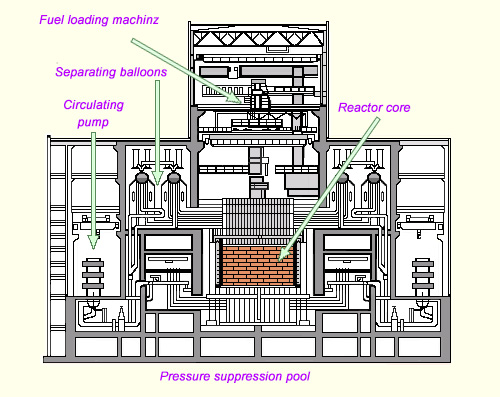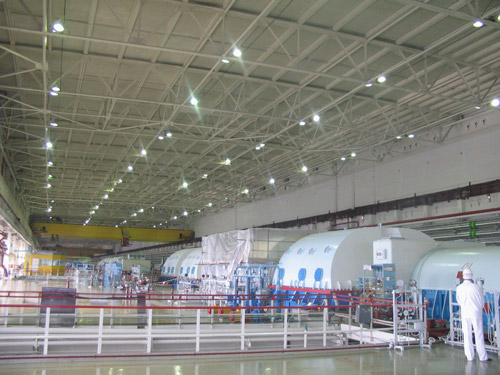Soviet-era reactors at Chernobyl
Cold War and the Iron Curtain led after 1947 to the development of separate reactors types in Western countries and in the Soviet Union. Espionage and secret service have far outweighed the lack of industrial contacts!

RBMK reactors
Simplified section of a 1000 MW RBMK reactor. Each fuel assembly is contained in a pressure tube inside which the cooling fluid circulates. 1700 pressure tubes are placed vertically in the stack of graphite bricks which acts as a moderator. Above the reactor, a reloading machine enables the continuous unloading and loading of fuel into the pressure tubes. During the accident, the graphite bricks caught fire and burned for 10 days, prolonging the release of radioactivity.
© IRSN
At the end of World War II, Americans had developed reactors at Hanford to produce the plutonium of their atomic bombs. These reactors were not used later for the production of electricity, but continued in Russia. The Soviets thus developed the RBMK reactors, enriched uranium reactors, the design of which stems from the first atomic prototypes. The RBMK family became tragically famous during the 1986 Chernobyl accident.
These reactors are graphite moderated and water cooled. The fuel is uranium oxide enriched with 2 to 2.6% uranium-235. The core is bulky, 20 times that of a PWR reactor. No pressure vessel, but a large number of vertical tubes, called “pressure tubes” containing the fuel. There is no containment enclosure. The Chernobyl reactor contained 190 tons of enriched uranium oxide distributed in 1681 “pressure tubes”.
Each pressure tube houses a uranium dioxide fuel assembly around which cooling water circulates at a pressure of approximately 70 atmospheres. The water acts as a coolant and supplies the steam directly used to drive the turbines (there is no steam generator). Fuel loading and unloading takes place continuously, without the need to shut down the reactor.
The characteristics of this reactor (boiling water, graphite as a moderator, slightly enriched fuel, absorbents, etc.) generate a reactor instability at certain operating regimes that should be avoided, particularly at low power. The temperature coefficient becomes positive there. A positive temperature coefficient means that an increase in temperature causes a new increase in temperature and so on. An initial disturbance is thus amplified. This destabilizing effect then makes it difficult to control the reactor. Control rods are used to control the effect. Since the 1986 accident, reactor operators have increased the number of control rods in the core and improved the speed of insertion of these rods, which was too slow.
This operational fragility contributed to the Chernobyl accident, but was not the primary reason. RBMK reactors had safety systems that could have played their role, but they had been deliberately disabled for a testing.

RBMK Smolensk Power Plant
Turbine hall of the Smolensk power plant. The 3 units of the Smolensk power plant are among the 11 RBMK units, still in service in Russia, which have been considerably modernized since the Chernobyl era. Their safety in particular has been completely reviewed. Based on these improvements, the operation of RBMKs has been extended.
© M.Chouha
The 11 Russian remaining units have undergone a major modernization program aimed at improving their safety. This program ended in 2010. As a result of these modernizations, the level of safety of the RBMKs has been very significantly raised. Their operation should last until around 2035. Unit No. 3 of the Smolensk power plant, equipped with the last RBMK-1000 commissioned in 1990, could be in operation until 2034.
See also :
Other articles on the subject « Nuclear Reactors »
Reactor Families
A variety of designs : Natural uranium or enriched uranium as fuel There are several industrial t[...]
World nuclear reactors
A development that takes place today in Asia At the beginning of 2014 the number of reactors in o[...]
Generation I reactors
1950-1970: First generation of reactors (50 – 500 MWe) The first generation reactors were i[...]
Generation II Reactors
1970-2009: the rise of nuclear energy About 85% of electricity produced worldwide by nuclear powe[...]
PWR Reactors
The most widespread type of reactor … Pressurised water reactors (PWR) are by far the most [...]
PWR Operation
High pressure water to evacuate heat and slow down neutrons The reactor core is the source of ene[...]
Boiling Water Reactors
BWR or Boiling Water Reactors Boiling water reactors or BWR are in operation in the United States[...]
Candu reactors
Canadian reactors using natural uranium and heavy water CANDU is a nuclear reactor brand develope[...]
Nuclear Propulsion
On-board reactors for submarines and aircraft carriers In addition to conventional land-based pow[...]